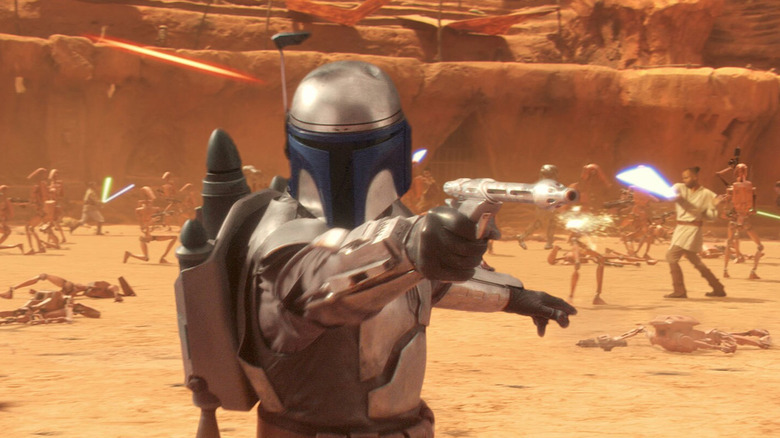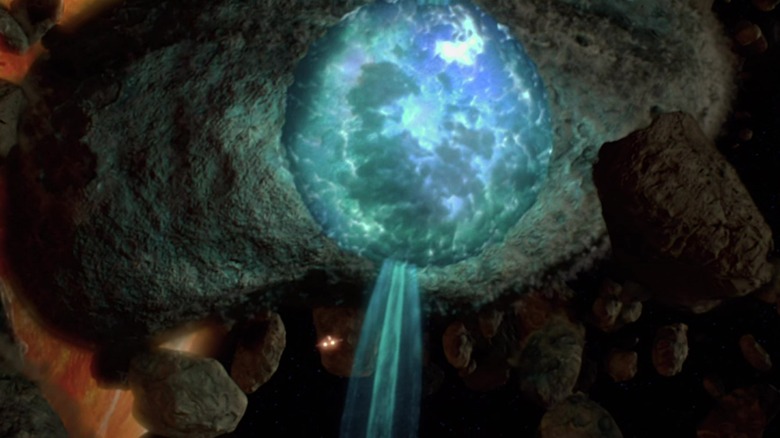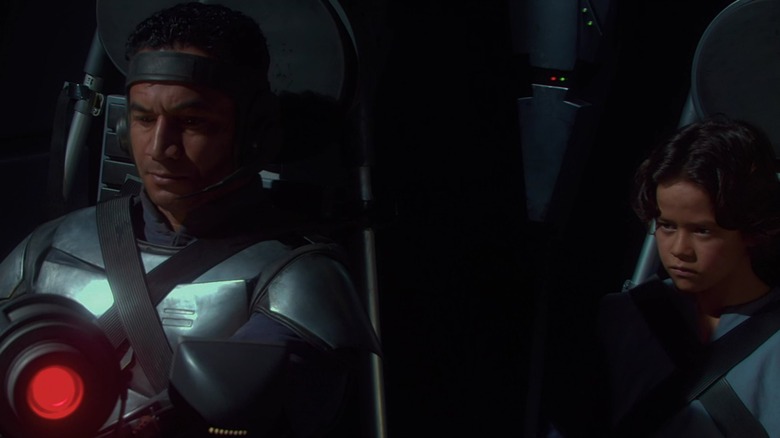The 25-Year Story Behind Star Wars: Attack Of The Clones' Seismic Charge Sound
In the B-plot of George Lucas' 2002 sci-fi romance "Star Wars: Episode II – Attack of the Clones," the stalwart Jedi Obi-Wan Kenobi (Ewan McGregor) is sent to an ocean planet called Kamino to apprehend an assassin who may be lurking there. Obi-Wan finds more than he expected, as Kamino is the home of a massive cloning facility that has been making duplicates of Jango Fett (Temuera Morrison) for years. There are now millions of him. When Jango Fett catches wise to Obi-Wan's investigation, he leaves Kamino in a miniature spacecraft while Obi-Wan pursues. In order to get Obi-Wan off his tail, Jango flies into a cluttered asteroid field and begins dropping explosive space mines called seismic charges.
The seismic charges, as dramatized in the film, are cylindrical objects that float out into space, hold steady for a moment, and then explode into a flash of blue fire. There is then a disc-shaped concussive ring of energy that emanates outward, destroying everything in its path. For a moment, the charges are silent, and then the explosion emits a "bwamp"-like orchestral noise instead of the expected "kaboom" sound effect one might usually hear from a movie explosion.
The sound was created by longtime "Star Wars" editor Ben Burtt, and he talked about the "bwamp" in the 64th issue of Star Wars Insider Magazine, published in December 2002, seven months after the release of "Attack of the Clones." In the magazine, Burtt explained that he selected the sound after tinkering with it for 25 years, having first made the noise for the original "Star Wars" in 1977. It took that long for his "bwamp" to be fully realized.
The explosion sound effects in Star Wars
Burtt originally envisioned — enlistened? — the explosions in "Star Wars" as more abstract sounds. Knowing there are no sound waves in space, and that there is no oxygen to burn up, Burtt thought blow-ups shouldn't sound like earthbound fireballs. He tinkered and came up with a few unused possibilities for "Star Wars" explosions, hoping to add a little extra surreal verse to the movie. One of them was the "bwamp." He said (via Star Wars Insider Magazine):
"I actually tried making a sound like that on the very first 'Star Wars' movie. I had an idea that explosions in space should sound different from explosions that we normally hear on Earth, and I remember making up a series of different and very odd-sounding explosions, about twenty-five years ago."
He also would sneak sound effects into the "Star Wars" movies, mostly to see if they worked:
"I used to do that all the time in order to experiment with sounds. This is how we discovered the laser sound, or the TIE fighter – I would make up a few possibilities, and at different times in the movie things would sound different. People might come up to me afterward and say, 'Wow, I really liked this particular sound for that starship.'"
The TIE fighters are, of course, the eyeball-shaped ships used by the evil Empire in the early "Star Wars" movies.
Burtt loved these abstract versions of explosions, but revealed that no one else seemed to. They all said that "bwamp"-like explosions were "too crazy and weird." Burtt, however, kept the noises in his own personal sound library, hoping to crack them out someday. By 2002, it seemed the world was ready.
Jango Fett's seismic charges
What changed between 1977 and 2002? Mostly the quality of sound recording. With a digital brush-up, the "bwamp" could be enhanced and made clearer and crisper. After 25 years of languishing in Burtt's personal sound archive, the "bwamp" now came alive. He said:
"When it came around in 'Attack of the Clones' to doing the seismic charges, I fished out some of the old recordings. Because there's new technology now, and higher fidelity for recording, I actually made up a couple of explosions that were similar in sound to those old ether explosions; same idea but much higher fidelity, digital, and so on. I used those, and everybody loved it. Its time had come."
Weirdly, no one commented on the old sound effect being re-used. Burtt recalled showing the final mix to Lucas, and Lucas merely nodded and moved to the next scene. For Burtt, a weird-ass sound effect finally matured into a usable form. For Lucas, it was merely acceptable. Burtt said, however, that he gets a lot of correspondence from other sound designers on his seismic charge effect, so he did at least get some validation from his peers. He also was proud of the fact that he edited in a moment of silence before the explosion, giving the bombs a "lightning-and-thunder" style delay. The delay, he said, was a last-minute decision:
"If you have no sound for a moment, people are left with an unsatisfied expectation, and then you surprise them with the sound. That's what I called an audio black hole. The explosion seems much bigger because there's been this silence."
While Burtt was nominated for an Oscar for his work on "Star Wars: Episode I – The Phantom Menace," he was not nominated for "Attack of the Clones."


